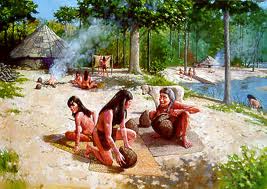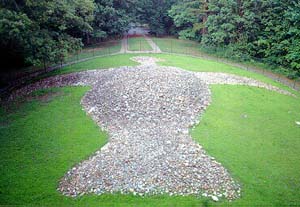
The term “Woodland” was introduced in the 1930s as a generic heading for prehistoric sites falling between the Archaichunting and gathering and the temple-mound-building Mississippian cultures in the eastern United States.
By the early 1960s, Woodland sites were generally characterized as those that regularly produced pottery and constructed burial mounds that contained elaborate grave goods. Although evidence was lacking, it was assumed that these burial mounds implied an agricultural-based economy to support the construction of these earthworks.

Traditional archeological interpretation of the evolution of prehistoric Native American cultures dictated that there was a clear line of division between Archaic peoples and Woodland pottery-making and agricultural peoples. By the mid-1960s, however, it was evident that in some areas of the United States prehistoric cultural groups with a clearly Archaic cultural assemblage were making pottery without any evidence of the cultivation of domesticated crops. In fact, it appears that hunting and gathering continued as the basic subsistence economy and that true agriculture did not occur in much of the Southeast for a couple of thousand years after the introduction of pottery.
In recent years archeologists in the southeastern United States have addressed the issue of agricultural development by investigating Woodland village sites to learn more about the subsistence patterns of the period. This has sometimes led to establishing cultural chronologies that separate Archaic from Woodland cultures with a transitional stage of cultural development, or to postulating alternative subsistence strategies for the cultures of the Early Woodland period in the Southeast.
In the Southeast, the Woodland period is now generally viewed as a cultural developmental stage or temporal unit dating from about 1000 B.C. to A.D. 1000. Rather than showing a wholesale change in material culture, archeology has shown a continuity in the development of Archaic and Woodland stone and bone tools for the acquisition, processing, storing, and preparation of animal and plant foods, leather working, textile manufacture, tool production, cultivation, and shelter construction. Some Woodland peoples continued to use Archaic-style spears and atlatls until the Late Woodland period (circa A.D. 800) when these were replaced by bow and arrow technology. The major technological change in the Woodland period, however, was the emergence of a distinct pottery-making tradition with definite vessel forms and decoration, although in the Southeast, pottery technology apparently began in the Late Archaic. There was also a culmination of an increasing sedentism, which first appeared in the Archaic, into permanently occupied villages.
Nutting stones, used for cracking the hard shell of a nut, had one or more hollowed out “socket” where the nut could rest. A second stone was used to crush the shell. These are easily confused with an anvil that also has dimples or sockets that result from bi-polar percussion flaking.
Of importance was a realization that the subsistence economy of the Woodland period was essentially similar to that of the Archaic period, utilizing seasonal exploitation of wild plants and animals but with the introduction of a system of planting and tending of garden crops and the intensive collecting of starchy seeds and autumnal nuts. This set the stage for agriculture economies of the later Mississippian period. Generally, the Woodland period is divided into three subperiods. The beginning and ending dates for these phases, however, are not consistent throughout the Southeast.
Gulf Formational (2000 – 100 B.C.) and Early Woodland (1000 – 300 B.C.)
If one uses the traditional definition of pottery introduction being equated with a Woodland tradition, then the earliest Woodland sites would be those found along the South Atlantic coast that have produced fiber-tempered pottery dating as early as 2500 B.C.
However, these sites are essentially Late Archaic seasonally occupied coastal base camps with a material cultural assemblage equivalent to that found on Archaic sites, and differentiated only by the addition of fiber-tempered pottery.
Researchers in the Southeast are attempting to define the beginnings of the Woodland period using not only the appearance of pottery but evidence of permanent settlements, intensive collection and/or horticulture of starchy seed plants, differentiation in social organization, and specialized activities, to name just a few topics of special interest. Most of these cultural aspects are clearly in place in parts of the Southeast by around 1000 B.C. The time period between about 2500 and 1000 B.C. should be considered a period of gradual transition from the Archaic to the Woodland.
Beginning around 2500 B.C., the Stallings Island culture established itself as a Late Archaic shellfish-collecting society that utilized the riverine and coastal environments, probably on a seasonal basis, leaving evidence of their occupation in the form of large shell middens. This cultural group used an Archaic material culture, but also created the first ceramics known in the United States. Called Stallings Island, these ceramics were named after a major shell midden site on an island in the Savannah River near Augusta, Georgia.
It was during the Gulf Formational period that fiber-tempered ceramics were replaced first by plain, then by fabric-impressed, and, later, by cord-marked sand-tempered Alexander ceramics.
Thom’s Creek pottery is a transitional type in north coastal Georgia tempered with fiber and sand. Satilla pottery is a transitional type of the same period also tempered with a blend of sand and fiber that occurs along the banks of the Satilla River in south-central Georgia.
Poverty Point sites in Louisiana and western Mississippi exhibit the first major residential settlements and monumental earthworks in the United States. Although the Poverty Point culture is not well understood in terms of social organization, it was involved in the transportation of non-local raw materials (for example, shell, stone, and copper) from throughout the eastern United States into the lower Mississippi River Valley to selected sites where the materials were worked into finished products and then traded.
Copper and red jasper beads from the Poverty Point site. The site has large portions of land with low ridges resembling broad plow furrows. Each furrow is laced with traces of artifact manufacture. Goods from this side have been recovered all across the Southeast.
While specific information on Poverty Point subsistence, trade mechanisms, and other cultural aspects is still speculative, the sites nevertheless exhibit specific material culture, such as baked clay objects, magnetite plummets, steatite bowls, red-jasper lapidary work, fiber-tempered pottery, and microlithic stone tools.
In Arkansas, Kentucky, Tennessee, and North Carolina, fiber-tempered pottery from the 2500 to 1000 B.C. period is not usually found. This area appears to have functioned as a transitional cultural area through which ceramic influences from the Ohio River Valley and the Middle Atlantic were introduced into the Deep South. For example, northern-inspired grit-tempered plain, fabric-impressed, and cord-marked Early Woodland pottery first appeared in central and eastern Kentucky around 1000 to 800 B.C., and, by the end of the Early Woodland period (800 to 500 B.C.), it had replaced fiber-tempered wares throughout the Southeast.
Early Woodland points in Georgia include the Adena, Baker’s Creek, Hernando, Citrus (Florida), Fairland, Little Bear Creek, Swan Lake (Jackson in Florida), Jack’s Reek Corner Notched, Swannanoa, Thelma, and Woodland Spike points and other types that became more dominant in the Middle Woodland period.
With the introduction of these northern-type ceramics came isolated mortuary sites with grave offerings. Some of the best examples of earthen enclosures and burial mounds dating to the Early Woodland Adena complex (circa 500 B.C.) were identified in the Ohio River Valley of Kentucky. Early Woodland projectile-point styles from Kentucky include Kramer, Wade, Gary, and Adena. These new ceramics later appeared in the mountains of western North Carolina during the Swannanoa period (700 to 300 B.C.).
Although plant domestication occurred sporadically in the Late Archaic, even possibly as early as the terminal Middle Archaic, generalized plant domestication, or horticulture, appears in Kentucky throughout the Early Woodland with intensive collecting of starchy seeds and tubers. These appear to have included sunflower, maygrass, sumpweed, giant ragweed, and knotweed.
As already noted, the Early Woodland of central Tennessee, interior Mississippi, and Alabama, began with the introduction of fiber-tempered ceramics in the Gulf Formational period (around 2000 B.C.) from the South Atlantic coast Stallings Island and Orange cultures. By the mid-Early Woodland period, Gulf Formational cultures developed their own fiber-tempered pottery styles, such as Wheeler, which was in turn replaced by the sand-tempered Alexander series. This area also participated in long-range exchanges with other areas of the Deep South in steatite, sandstone, Tallahatta quartzite, and ceramics.
Eastern North Carolina, during the Early Woodland period (1000 to 300 B.C.), exhibits both Southeast and Middle Atlantic influences called New River and Deep Creek, respectively. The Early Woodland New River, found south of the Neuse River, appears to be a continuation of the Stallings Island, Thom’s Creek, and Deptford cultures from Georgia and South Carolina. Meanwhile, north of the Neuse River, the Early Woodland Deep Creek culture produced Marcey Creek plain and cord-marked ceramics much like those from Virginia.
The Early Woodland Deptford ceramics appear to have developed in Georgia (circa 800 B.C.) out of the Early Woodland Refuge phase (1000 to 500 B.C.) and spread north into the Carolinas and south into Florida. Deptford ceramics continued to be made and found on Middle Woodland sites in the Southeast up through about A.D. 600. Subsistence for the coast and coastal plains of Georgia and the Carolinas appears to have followed a transhumant (or seasonal) pattern of winter shellfish camps on the coast, then inland occupation during the spring and summer for deer hunting, and fall for nut gathering.
In northern Georgia the appearance of Dunlap fabric-marked ceramics (circa 1000 B.C.) marks the beginning of the Early Woodland Kellogg focus. These types of ceramics are replaced by Middle Woodland ceramics (Cartersville plain, checked, and simple stamped) after about 300 B.C.
By around 500 B.C., the Poverty Point culture was replaced by the Tchula/Tchefuncte Early Woodland culture, which existed in western Tennessee, Louisiana, southern Arkansas, western Mississippi, and coastal Alabama. The sites of this lower Mississippi River Valley culture were small village settlements. Subsistence continued to consist of intensive collecting of wild plants and animals, as with the preceding Poverty Point culture, but for the first time quantities of pottery were produced. There appears to be a de-emphasis on long-distance trade and manufacture of lithic artwork noted in the earlier Poverty Point culture. The Tchula/Tchefuncte Early Woodland culture appears to have coexisted with some Middle Woodland cultures in the lower Mississippi River Valley.